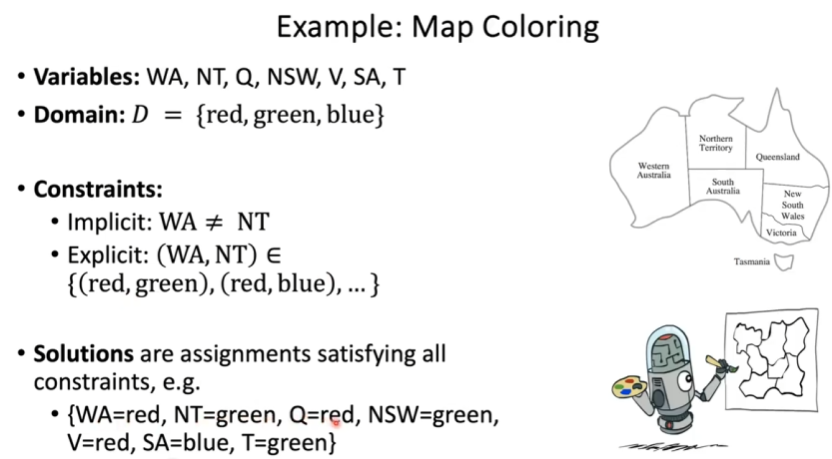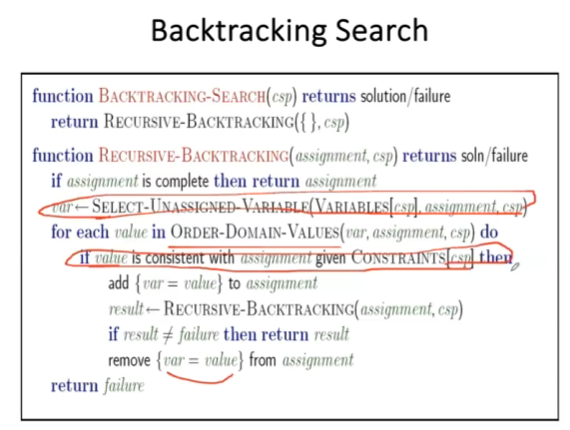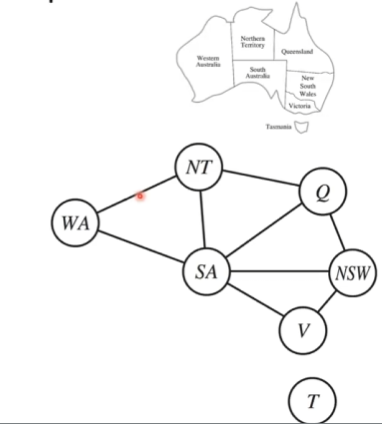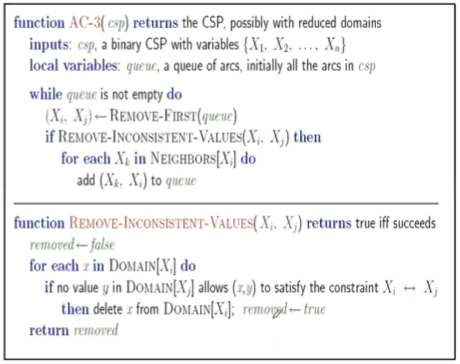Recap
Search/Planning:
Sequences of actions
- Path to goal is important thing
Identification
Assignments to variables
- Goal itself is important, not the path
- All paths at the same depth
Constraint Satisfaction Problems
Standard Search Problems:
- State is a “black box” (arbitrary data structure)
- Goal test can be any function over states
Constraint Satisfaction Problems (CSPs)
A special subset of search problems.
- State is defined by variables with values from a domain
- Goal test is a set of constraints specifying allowable combinations of values for subsets of variables.
- Allows useful general-purpose algorithms with more power than standard search algs.
Example: Map Coloring
- Want to color map regions certain colors (say red, green, blue), and want neighbors to NOT have the same color.

Example: N-Queens
- Variables:
- Domain:
- Constraints:
- Implicit:
- Explicit:
- Implicit:
Example: Sudoku
- Objective: Fill empty cells with numbers 1-9
- Rules:
- Numbers appear once each row, column, and region.
- Variables
- is cell on row.
- Constraints
- Row:
- Column:
- Block: ( denotes block)
Variety of CSP Constraints
- Unary Constraints
- Involve single variable (equivalent to reducing domains)
- e.g.
- Binary Constraints
- Involve pairs of variables
- e.g.
- Higher-Order Constraints involve 3 or more variables (e.g. Sudoku)
- Preferences (soft constraints)
- e.g. red is better than green
- Often represented by cost for each variable assignment
- Gives constrained optimization problems
Constraint Graphs
- Binary CSP
- Each constraint relates at most 2 variables
- Binary Constraint Graph
- Nodes are variables, arcs show constraints
- General-Purpose CSP algorithms use the graph structure to speed up search.
Solving CSPs
Standard Search Formulaton
- States defined by values assigned so far
- Initial State: empty assignment, {}
- Action (Successor Function): Assign a value to a unassigned variable.
- Goal Test: The current assignment is complete and satisfies all constraints.
- “Search Tree”: Explore graph using BFS
- Problem: Inefficient, expands invalid states, reaches duplicate states
Backtracking Search
- Idea 1: One variable at a time - Variables are expected to be commutative - Fix ordering of variables and only consider assignments to single variables at a time.
- Idea 2: Check constraints as you go
- ”Incremental Goal Test” - Consider values only which do not conflict with previous assignments.

Improving Backtracking
- Can we detect failure early?
- Filtering: Keep track of domains for unassigned variables and cross off bad options
- Forward Checking: Cross off values that violate a constraint when a value assignment is added to existing assignment
- Ordering
- Which variable assigned next?
- Which order should its values be tried?
- Structure
- Can we exploit problem structure?
Filtering
Consistency of a Single Arc
- An arc is consistent iff for every x in the tail there exists some y in the head which could be assigned without violating a constraint.
- Forward Checking: Enforcing consistency of arcs from unassigned variables (i.e X) pointing to the variables with a new assignment (i.e. Y)
Arc Consistency of an Entire CSP
- Important: If loses a value, neighbors of need to be rechecked!
- Simple form of propagation that makes sure all arcs are consistent.
- :
- :
K-Consistency
- Increasing degrees of consistency
- 1-Consistency (Node Consistency): Each single node’s domain has a value which meets that node’s unary constraints
- 2-Consistency (Arc Consistency): For each pair of nodes, any consistent assignment to one can be extended to another.
- K-Consistency: For each nodes, any consistent assignment to can be extended to the node.

